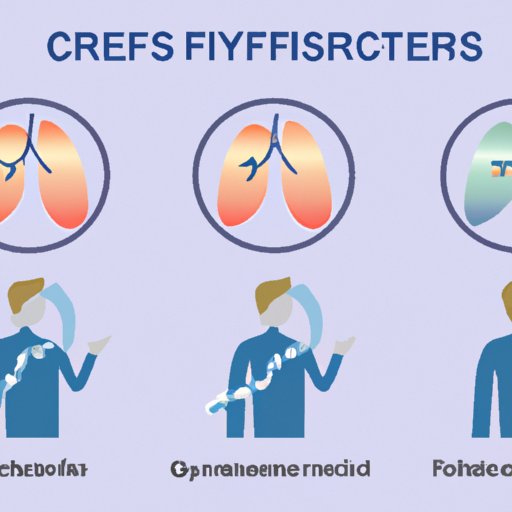
Introduction
Cystic Fibrosis Disease is a genetic disorder that affects the respiratory and digestive systems. While it is a relatively rare condition, those who are affected by it face many challenges both physically and emotionally. The purpose of this article is to provide helpful information to anyone who has encountered this problem.
Unlocking the Mysteries Behind Cystic Fibrosis Disease
Cystic Fibrosis Disease was first discovered in the 1930s, but it wasn’t until the 1950s that there was a breakthrough in understanding the genetic basis of the condition. Scientists have been studying cystic fibrosis disease ever since, but it is still considered something of a mystery in the medical world. This is in part because the disease affects many different parts of the body, including the lungs, pancreas, and liver, and there are multiple genetic mutations that can lead to the condition.
Understanding Cystic Fibrosis Disease: Symptoms, Causes, and Treatment Options
The symptoms of cystic fibrosis disease can vary from person to person but generally include respiratory problems such as a persistent cough, shortness of breath, and frequent lung infections. Digestive symptoms can also occur, including poor weight gain, malnutrition, and pancreatitis.
The genetic mutations that cause cystic fibrosis disease affect the production of a protein called CFTR, which regulates the movement of salt and water in and out of cells. When the CFTR protein is not working correctly, it leads to the buildup of thick, sticky mucus in the lungs and other organs.
While there is no cure for cystic fibrosis disease, there are a variety of treatment options available that can help manage symptoms and improve quality of life. This includes medications that help break up mucus, antibiotics to treat infections, and therapies such as physical therapy and exercise.
The Science Behind Cystic Fibrosis Disease and How It Affects the Body
Cystic fibrosis disease affects the body on a cellular level, leading to the buildup of mucus in the lungs and other organs. This mucus can make it difficult to breathe and increases the risk of infection. Over time, the damage to the lungs can become severe enough to require a lung transplant.
The disease can also impact other parts of the body, including the pancreas, liver, and reproductive organs. This can lead to complications such as pancreatitis, cirrhosis, and infertility.
Cystic Fibrosis Disease: Living with a Chronic Condition
Living with cystic fibrosis disease can be challenging. Managing symptoms, maintaining a healthy lifestyle, and balancing medical treatments with everyday life can be complicated. It is important for people with cystic fibrosis disease to work closely with their healthcare team to develop a personalized treatment plan.
Some tips for living with cystic fibrosis disease include:
– Staying active: Exercise can help improve lung function and overall health.
– Eating a balanced diet: People with cystic fibrosis disease often have trouble gaining weight, so it is important to eat a diet that is high in calories and nutrients.
– Staying up to date with vaccinations: People with cystic fibrosis disease are at a higher risk of developing infections, so it is important to receive all recommended vaccines.
– Practicing good hygiene: Regular hand washing and avoiding contact with sick people can help reduce the risk of infection.
Explainer: Everything You Need to Know About Cystic Fibrosis Disease
Cystic Fibrosis Disease is a genetic disorder that affects the respiratory and digestive systems. It is caused by mutations in the CFTR gene, which leads to the buildup of thick, sticky mucus in the lungs and other organs. Symptoms can include respiratory problems, digestive issues, poor weight gain, and malnutrition.
While there is no cure for cystic fibrosis disease, there are a variety of treatment options available that can help manage symptoms and improve quality of life. This includes medications, antibiotics, and therapies such as physical therapy and exercise.

The Latest Research on Cystic Fibrosis Disease and Future Treatment Prospects
There have been many recent advancements in cystic fibrosis disease research, including the development of new medications and therapies. One promising area of research is gene therapy, which involves introducing healthy copies of the CFTR gene into cells to correct the genetic mutations that cause the disease.
Future treatment prospects for cystic fibrosis disease are promising, but there is still much work to be done. It is important for patients to stay up to date with the latest research and talk to their healthcare team about potential new treatments and therapies.
A Personal Account: Living with Cystic Fibrosis Disease and Overcoming Challenges
Living with cystic fibrosis disease can be difficult, but many people with the condition have found ways to overcome challenges and lead fulfilling lives. One person who has lived with cystic fibrosis disease for a long time shares their story of resilience and perseverance, emphasizing the importance of staying positive and maintaining a strong support system.
Conclusion
Cystic Fibrosis Disease is a complex condition that affects many different parts of the body. By understanding the symptoms, causes, and treatment options, people with cystic fibrosis disease can take control of their health and improve their quality of life. It is important for healthcare providers, loved ones, and the broader community to spread awareness about cystic fibrosis disease and support those who are living with it.




